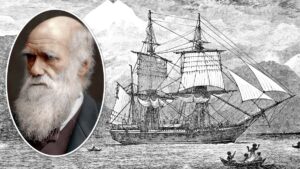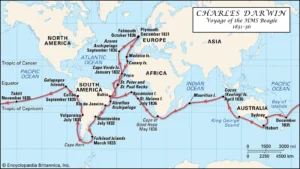The essence of scientific progress lies within the voyages of intellectual exploration embarked upon by remarkable individuals throughout history. In the early 19th century, one such voyage changed our understanding of life on Earth forever. Join us as we delve into the iconic journey of Charles Darwin onboard the HMS Beagle, a voyage that laid the foundation for his groundbreaking theory of evolution by natural selection.


Setting Sail on the HMS Beagle:
In December 1831, a young naturalist named Charles Darwin embarked on a five-year voyage aboard the HMS Beagle, setting off to survey the South American coastline and conduct various scientific investigations. Little did he know that this unforgettable journey would forever shape our understanding of the natural world.
Discoveries and Observations:
Throughout the voyage, Darwin meticulously collected and cataloged an impressive array of plant and animal specimens, fossils, and geological samples. His keen observations led him to question prevailing beliefs about the origins and diversity of life, igniting the spark of his revolutionary theory.
Galapagos Islands: Nature’s Living Laboratory:
The Galapagos Islands, located in the Pacific Ocean, proved to be a pivotal point in Darwin’s journey. The unique fauna inhabiting these islands, notably the finches, tortoises, and iguanas, showcased extraordinary adaptations to their specific environments. Darwin’s observations of these distinct species laid the groundwork for his theory of natural selection, suggesting that species evolved over time due to environmental pressures.
Fossil Record and Geology:
Beyond the Galapagos, Darwin’s interests extended to the study of fossils and geology. In Patagonia, South America, he discovered fossilized remains of extinct mammals that resembled living species in other parts of the world. This evidence challenged the prevailing belief in the fixity of species and hinted at a complex and interconnected web of evolutionary history.
The Journey Homeward:
As the HMS Beagle made its way back to England, Darwin continued to analyze his abundant collection of specimens, notes, and journals. This arduous task led him to develop a comprehensive understanding of the natural world, with his theories starting to take shape.
Publication of “On the Origin of Species”:
In 1859, after more than two decades of exhaustive research and contemplation, Darwin’s masterpiece, “On the Origin of Species,” was published. This groundbreaking work presented his theory of evolution by natural selection, revolutionizing our understanding of life’s diversity and interconnectedness.
Legacy and Impact:
The publication of Darwin’s theory triggered a profound paradigm shift in scientific and cultural circles. The concept of evolution by natural selection challenged traditional beliefs and established the foundation for modern biology. Darwin’s voyage on the HMS Beagle and his subsequent work remains a testament to the power of scientific curiosity and the transformative nature of intellectual exploration.
Conclusion:
The journey of Charles Darwin on the HMS Beagle proved to be an epic voyage that forever altered humanity’s perspective on the natural world. From the captivating species found on the Galapagos Islands to the vast geological insights gathered onboard, Darwin’s observations and discoveries paved the way for his groundbreaking theory of evolution by natural selection. This voyage stands as a testament to the power of scientific inquiry and its ability to reshape our understanding of life’s intricate processes.

